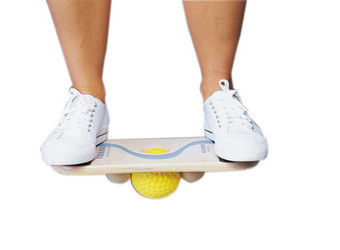Improving Balance in Fitness and Physical Therapy Settings
Balance boards and Balance Pads are prevalent in both the healthcare and fitness realms to enhance balance, stability, coordination, and proprioception — the awareness of one's body position in space. These tools play a pivotal role in promoting overall well-being and physical functionality through their multifaceted applications
Fitness Settings
Balance Training: In fitness routines, balance boards and pads serve to intensify balance and stability challenges. Utilizing these unstable surfaces prompts engagement of muscles throughout the body to sustain equilibrium, thereby fostering improved balance and core strength.
Core Strengthening: Balancing on these surfaces necessitates the activation of core muscles to stabilize the body. This engagement facilitates the strengthening of core muscles, including the abdominals, obliques, and lower back.
Enhanced Performance: Athletes integrate balance training into their regimens to augment performance in activities demanding agility, coordination, and balance, such as surfing, snowboarding, or martial arts.
Physical Therapy Settings
Rehabilitation: Within physical therapy, balance boards and pads serve as invaluable aids in rehabilitating various injuries, particularly those impacting the lower extremities and vestibular system. They aid individuals in regaining strength, stability, and proprioception post-injuries like ankle sprains, knee injuries, or vestibular disorders.
Fall Prevention: For individuals prone to falls, like older adults or those with neurological conditions, balance training utilizing boards and pads can mitigate fall risks by enhancing stability and coordination, thereby reducing the likelihood of falls.
Neuromuscular Training: Individuals grappling with neurological conditions such as stroke or Parkinson's disease benefit from balance training, which enhances neuromuscular control and coordination, fostering improved functional abilities.
Overall, balance boards and balance pads serve as versatile assets applicable across various contexts to enhance balance, stability, and overall physical performance. Their utility extends to both fitness and physical therapy practices, underscoring their significance in promoting holistic well-being and functionality.
Recent Posts
-
What to Expect During Hand Therapy: A Guide for Patients and Caregivers
If you’re starting hand therapy—whether after surgery, a stroke, or a neurological …Apr 6th 2025 -
Improve Hand Function and Dexterity with the Neofect Smart Pegboard
The Neofect Smart Pegboard is a revolutionary tool in the field of occupational therapy. I …Mar 25th 2025 -
Overcoming Challenges in Sports Medicine Clinics: Tips for Success
Running a sports medicine clinic presents unique challenges that require a balance of clinical exper …Dec 2nd 2024




